…
London | December 2015
…
How did you become an artist?
My background is in theatre and I’ve always used drawing as a way of expressing ideas within the theatre world. I did some set and costume design while studying at university and I’m always interested in developing the visual aspect of the work I create on stage as a director. I realised during my MA (in visual language and performance) that the drawing became more important than the actual performance I was drawing for and I found myself constantly drawing this weird cityscape. I had some sort of compulsion to do it and understand it.
…
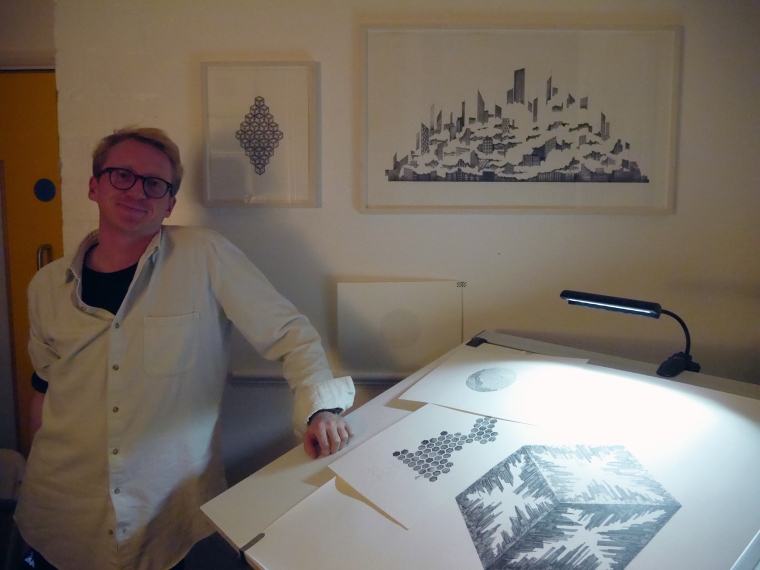 Alex in his studio in Bubble London in November 2015
Alex in his studio in Bubble London in November 2015
…
Are these cityscapes cities that you know or are they imagined?
They’re imagined. It’s almost like a pattern of a city, a recurring motif of a city. It’s always a skyline. I’m interested in the broad gesture of a city, the pattern that the entirety of it makes. I don’t draw specific buildings but often people see buildings that they know, which I like. I like that people see their own experiences in the work.
…
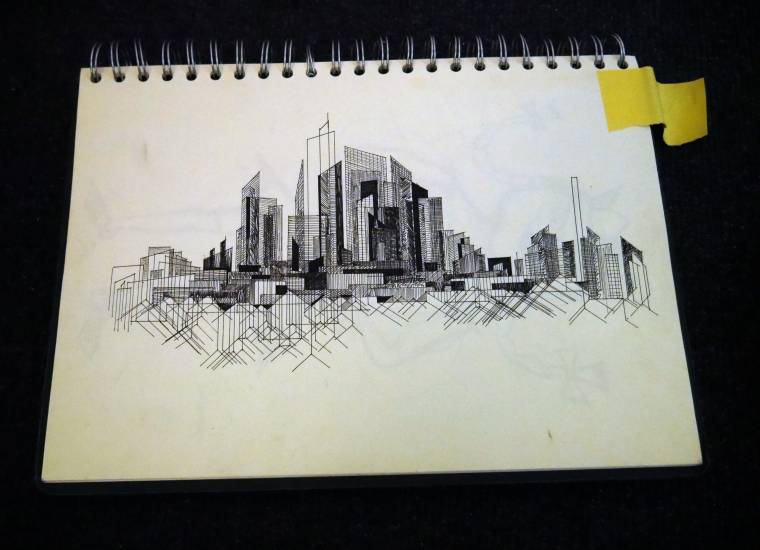 Some sketches from Alex’s notebooks
Some sketches from Alex’s notebooks
…
Your work is quite exact and mathematical…
Yes, I use geometry as a way to describe architecture. It is important to me that the work is geometrically and mathematically sound. I use a compass and ruler to create the different planes and lines. These cubes (in Tessellation below) are drawn to the specific measurements at the Alhambra Palace in Granada in Spain.
…
Tessellation, Pen on Paper, 27 x 35cm. Image courtesy of the artist
…
I went to Granada on a drawing holiday and I was fascinated by the Alhambra. It was the last remaining Muslim palace in Spain until the late 1400s and has the most amazing geometric Islamic tiling in the western world. The tilings were mathematically created to correspond to a pattern of concentric circles which form the ‘flower of life’. It was christened the flower of life in the 70s, but it is one of the first patterns created by man and is found on ancient sites across the world. You can repeat the flower of life form hundreds or thousands of times to create complex continuous patterns. So I often use these ancient mathematical structures to inform the dimensions and composition of my drawings.
…
Was there always an architectural theme in your work?
Yes. I grew up in Milton Keynes, a town in Buckinghamshire, which only formally became a town in 1967. So I grew up in a “new place” and it really informed me as a person. I saw the environment change from year to year and in a place like that you really feel the formation of your community. I was always really interested in architecture from a young age because of that.
…
 Some ideas being brought to life…
Some ideas being brought to life…
 Spiral, Pen on Paper, 27 x 35. Image courtesy of the artist
Spiral, Pen on Paper, 27 x 35. Image courtesy of the artist
…
What kind of research or reading informs your work?
I read a lot about architecture, much more than I do about art. I’m interested in the architectural history of the 20th century. My interest really started with Constantinos Doxiadis, a Greek architect who developed “ekistics” which is the study of human settlements. I just started reading about his work and it evolved from there. Recently I’ve been reading a lot of architectural theories on subtraction, the Anthropocene Epoch and a great book called Horror in Architecture (Comaroff and Ong).
My reading always relates to what I want to draw next and so I’ve done a lot of reading about the ‘pleating’ technique and how lines work. How you can take a line, double your pen on that line and then double that again and so on. It’s the study of the way things grow. It’s also related to scale, for example how a tree in its entirety might also be the same shape as one of its leaves – the repeated pattern of many small things makes a whole. In my art I am constantly looking at nature and at mathematics and seeing how I can express an idea of growth within urban and architectural contexts.
After this research into pleating I looked at a lot of trees in London and omitted the shapes of the trees; I drew the architectural features around the blank space. It became an exercise in negative space which has influenced a number of recent works.
…
Do you have a favourite method of working?
Well the Truncated Icosidodecahedron was very complicated to figure out, but once I’d planned it out, drawn the outline and knew what I was going to do, it was just about sitting down and doing it. There was a small drawing of it online and I worked out the pattern from that. I made a template, paper cut that and went from there.
…
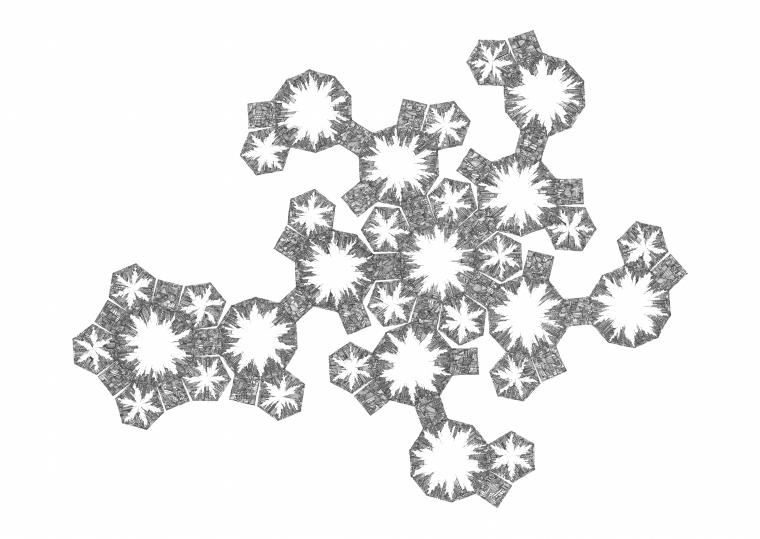 Truncated Icosidodecahedron, Pen on Paper, 2014. Image courtesy of the artist
Truncated Icosidodecahedron, Pen on Paper, 2014. Image courtesy of the artist
…
This one, Drift (below), was such a long draw because I had no advance plan for what the white space would look like. Every line that meets that white space is the result of a spontaneous decision at the time. This will eventually be part of a group of works which explore the idea of negative space and subtraction. The white spaces for me represent time and conflict; power that’s moving through this one site of human experience. People do bring their own interpretations to it, like seeing New York on a foggy day. For me it’s about time and cities and the way that they change and evolve like living organisms in their own right.
…
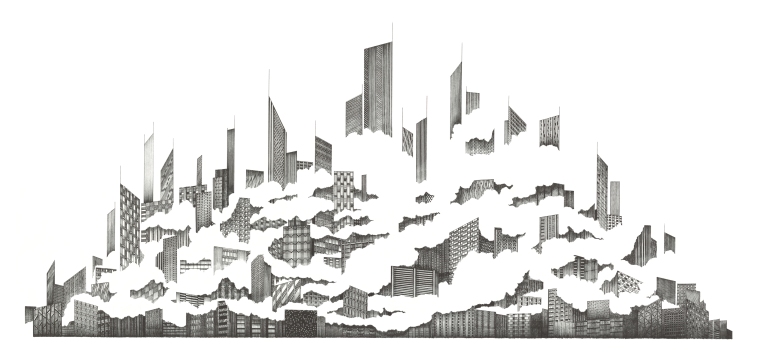 Drift, Pen on Paper, 45 x 84 cm. Image courtesy of the artist
Drift, Pen on Paper, 45 x 84 cm. Image courtesy of the artist
Both of these examples are quite different ways of working so it keeps things interesting.
…
How long do the works take?
It varies. Sometimes drawing a work can take months. One particular work took the best part of a year to draw. I have also done some smaller ones in one sitting. I’ll often draw a big one and a small one at the same time because it can be quite monotonous constantly creating the same texture or making the same movement with the hand.
…
Can you talk me through one of your drawings? The large cube, Block.
I created a template and fixed the six outer points first, then drew the main structural connecting lines in pencil and then worked out where the parallel lines would go in order to create the illusion of three dimensionality. I did this using a ruler and 0.2 Staedtler pen making occasional marks to ensure that the lines were parallel. It’s almost like a sound score. Then I use the ruler to determine where the tops of the buildings will be – that determines where the white space will be. Then I make free hand lines that determine the different patterns you can see throughout. It can be quite gestural. There are times when I have to be very tight and focused, but there are other times when it’s much more impulsive.
…
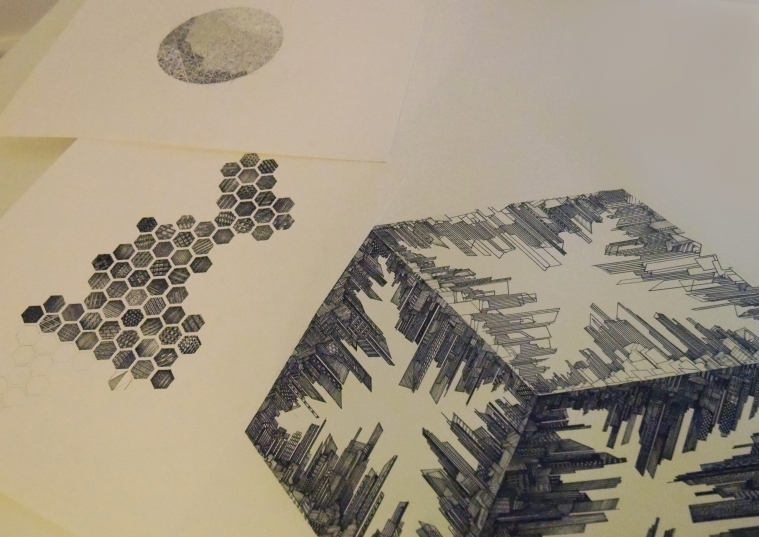 Block and some other works going on in the studio during my visit in November 2015
Block and some other works going on in the studio during my visit in November 2015
…
I’ve just started some work with graphite. I don’t know if I will ever draw in just pencil alone, but I’m working on a series at the moment, a mixture of pencil and pen and I’ve realised that I can achieve another two layers of tone with the pencil.
…
Would you like to see your work coming off the paper; moving to the three dimensional world?
The intention with Block is that I will work with a digital designer and use this as the building blocks for further limited edition prints. I’d love to create a work that can be printed out over the side of a building, or etched onto glass or steel. Block could hopefully become a blueprint of a real life environment. I’m interested in making big hoardings, temporary structures and environments and permanent interventions in buildings using decorative steelwork or glass.
…
Who are your big influences? People or particular works?
A lot of architects. Edwin Lutyens who designed monuments, commemorative cenotaphs and mass graves after World War I. Charles Holden the architect who designed Senate House. Le Corbusier. M. C. Escher. Hugh Ferris’ architectural renderings of New York are so beautiful and have influenced so many later interpretations of cities.
…
What’s next?
I feel like I’ve started a lot of things and I haven’t finished enough of them yet. For instance, I’m interested in turning Drift into a large series. There will be a version with no white spaces and the next one will be similar again but with a little bit of white and so on.
I also make short films, mostly Vines at the moment, so I would like to scale those up a bit. They’re films of my drawing process. I want to turn my studio into something like a working television set; hang the camera from the ceiling and do time lapses. I like to give people an insight into my process.
But really I’m looking forward to drawing and exhibiting more, to developing new work and creating partnerships and collaborations where my work can be shared to new audiences. It’s great to see my work up on the wall being explored and appreciated, there’s no other feeling like that.
…
One of the short videos Alex made in 2015
…
To see more from Alex check out his website here: http://www.alexanderevans.net/
…
…

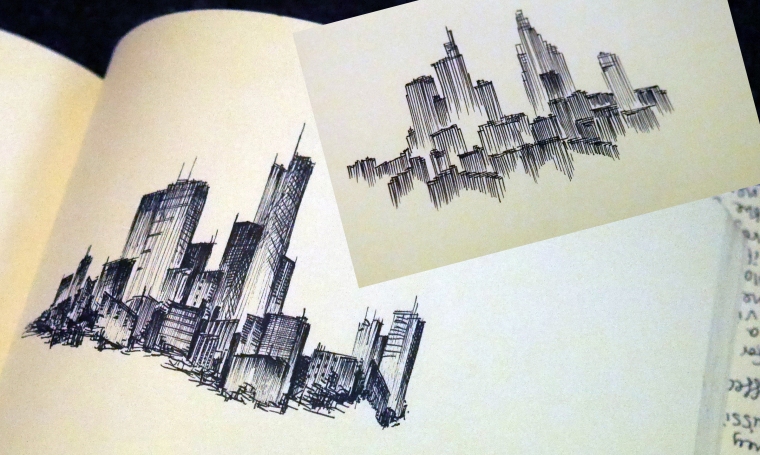
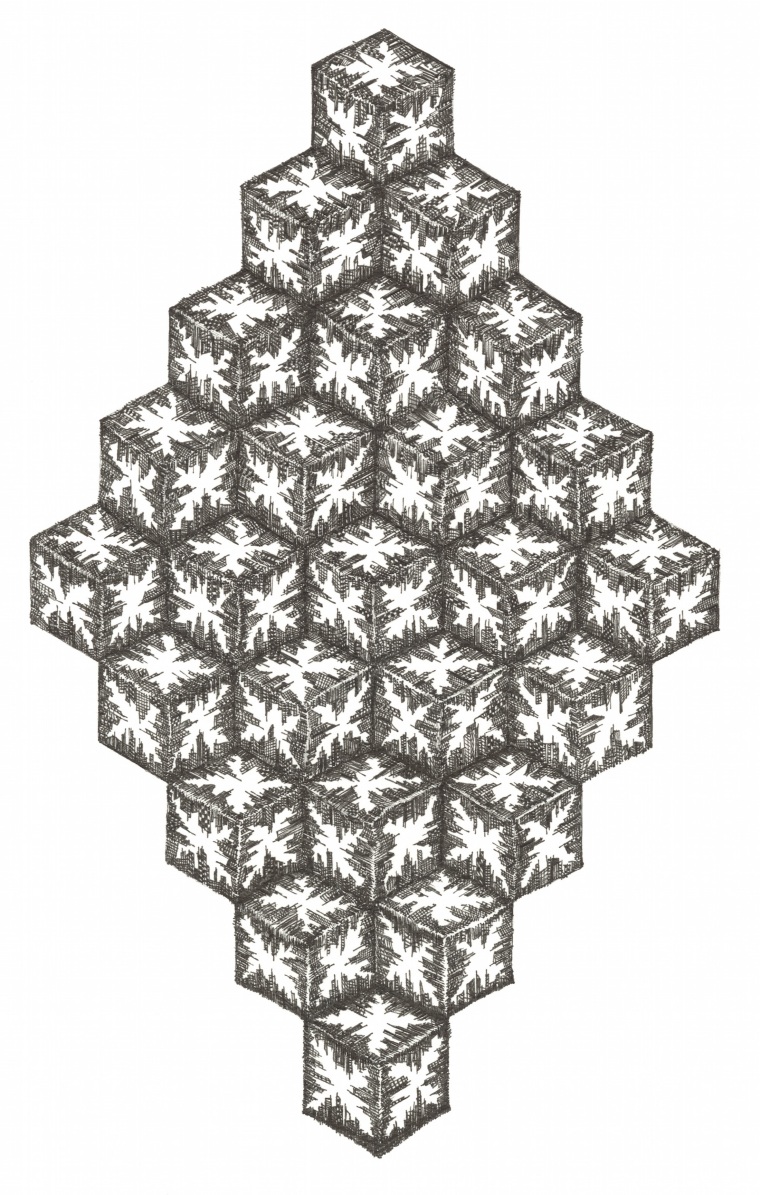
Leave a comment